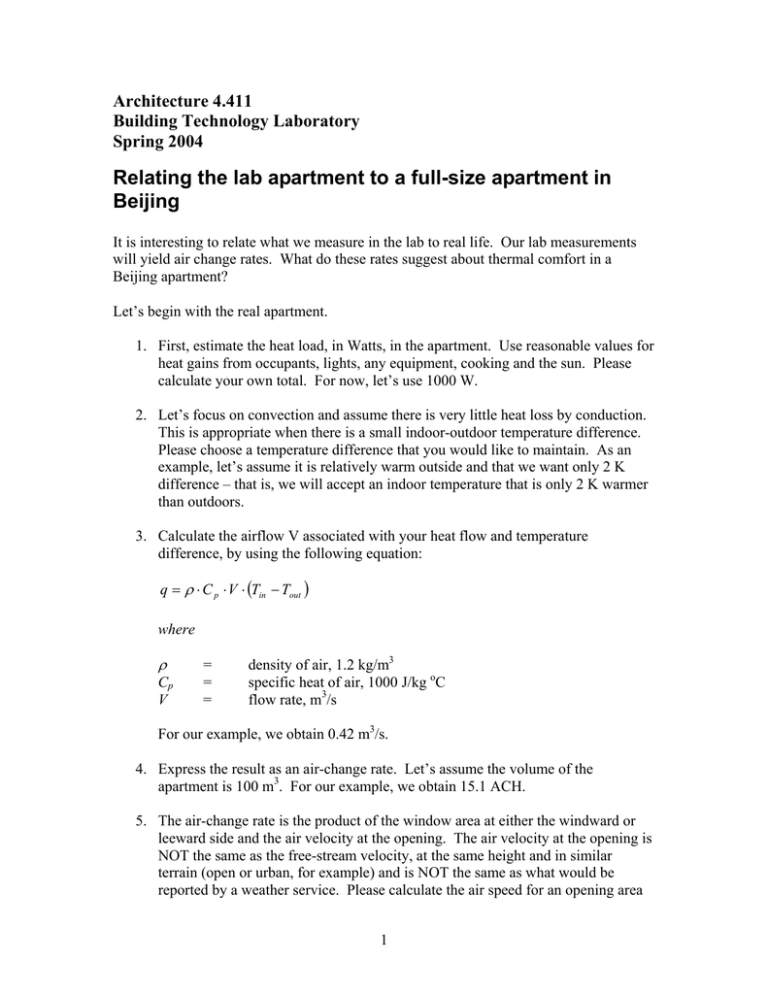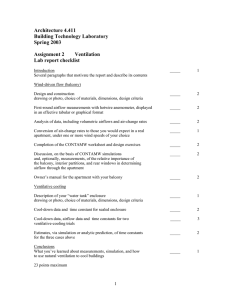Relating the lab apartment to a full-size apartment in Beijing Architecture 4.411
advertisement

Architecture 4.411 Building Technology Laboratory Spring 2004 Relating the lab apartment to a full-size apartment in Beijing It is interesting to relate what we measure in the lab to real life. Our lab measurements will yield air change rates. What do these rates suggest about thermal comfort in a Beijing apartment? Let’s begin with the real apartment. 1. First, estimate the heat load, in Watts, in the apartment. Use reasonable values for heat gains from occupants, lights, any equipment, cooking and the sun. Please calculate your own total. For now, let’s use 1000 W. 2. Let’s focus on convection and assume there is very little heat loss by conduction. This is appropriate when there is a small indoor-outdoor temperature difference. Please choose a temperature difference that you would like to maintain. As an example, let’s assume it is relatively warm outside and that we want only 2 K difference – that is, we will accept an indoor temperature that is only 2 K warmer than outdoors. 3. Calculate the airflow V associated with your heat flow and temperature difference, by using the following equation: q = ρ ⋅ C p ⋅V ⋅ (Tin − Tout ) where ρ Cp V = = = density of air, 1.2 kg/m3 specific heat of air, 1000 J/kg oC flow rate, m3/s For our example, we obtain 0.42 m3/s. 4. Express the result as an air-change rate. Let’s assume the volume of the apartment is 100 m3. For our example, we obtain 15.1 ACH. 5. The air-change rate is the product of the window area at either the windward or leeward side and the air velocity at the opening. The air velocity at the opening is NOT the same as the free-stream velocity, at the same height and in similar terrain (open or urban, for example) and is NOT the same as what would be reported by a weather service. Please calculate the air speed for an opening area 1 of your choice. If we use the numbers we have so far and assume we have 2 m2 of opening, somewhere between one and two balcony doors, we then need 0.21 m/s as measured at the opening. 6. Now let’s look at the model. The scale factor, n, is 10, meaning that the model is built to a scale of 1:10. Let’s use subscripts “r” for the real apartment and “m” for the model. Please examine and understand the following equations: ACH r = WindowArea r ⋅ AirVelocity r ⋅ 3600 Volumer ACH m = WindowArea m ⋅ AirVelocity m ⋅ 3600 Volumem WindowArea m = Volume m = ACH m = WindowArea r n2 Volumer n3 WindowArea r ⋅ AirVelocity m ⋅ n ⋅ 3600 Volumer ACH m = ACH r ⋅ AirVelocity m ⋅n AirVelocity r For example, let’s imagine setting up the fan and the model such that we measure the same air velocity at the opening into the living room of our model as we calculated we would need to be comfortable in Beijing, 0.21 m/s. Our model airchange rate is then ten times what we need in real life, or 151 ACH. 7. Please set up a table that determines the air-change rate in a real apartment that is associated with what you measure in the lab, for different values of measured air exchange in the lab and assumed air velocity in real life. Use Table 1 as a template. Note for each of the four measurement cases, you should assume two velocities in real life. The two assumed values may differ for different wind directions. 2 Table 1. Comparison of airflows in modeled and full-size apartments Case number and/or description Model velocity at apartment entrance Model ACH Assumed real velocity Calculated Calculated real ACH real temperature difference Thermally comfortable for Tout = 25 oC? No balcony Balcony 0o wind direction Balcony 30o wind direction Balcony 60o wind direction 8. This table implies a certain freedom of choice in the lab. We can use whatever fan speed we want and relate the results to what would happen in real life. That’s true to a point: we can indeed predict the air-change rate in real life. But will our prediction be a good one? A good prediction means that the fluid dynamics associated with our model will be the same as in real life. To ensure that is the case, we must ensure that a non-dimensional parameter known as the Reynolds Number is the same for both the model and in real life. This in turn requires that AirVelocity m = AirVelocity r ⋅ n So, if we want 0.21 m/s in real life, we will need 2.1 m/s in the lab. Put the other way, we can start with what we measure in the lab and identify the air velocity, ACH and temperature difference in real life. Note that the lab velocity is ten times that of real life, in our case. This scaling factor is an issue for wind-tunnel work. If the scale factor is greater than ten or we want to simulate what we would have under high wind speeds in real life, we will need a very powerful lab fan. Our table-top fans are good for no more than about 5 m/s. Note also that if we match Reynolds Numbers, the ACH in our model will exceed that in a real apartment by a factor of n2, or 100 in this case, based on the last equation on page 2 and the equation on this page. 3 Please fill in the following table, using model velocities you measure in the lab (same model measurements as in Table 1): Table 2. Comparison of airflows in modeled and full-size apartments that preserve fluidmechanics similitude Model velocity at apartment entrance Case number and/or description Model ACH Real velocity that matches Reynolds Number Calculated Calculated real ACH real temperature difference Thermally comfortable for Tout = 25 oC? No balcony Balcony 0o wind direction Balcony 30o wind direction Balcony 60o wind direction Derivation of Reynolds Number similitude Conservation of momentum in two dimensions for an incompressible fluid yields the Navier-Stokes equations: ⎛ ∂ 2u ∂ 2u ⎞ ⎛ ∂u ∂P ∂u ∂u ⎞ +u + µ ⋅ ⎜⎜ 2 + 2 ⎟⎟ + v ⎟⎟ = − ∂x ∂x ∂y ⎠ ∂y ⎠ ⎝ ∂t ⎝ ∂x ρ ⋅ ⎜⎜ ⎛ ∂ 2v ∂ 2v ⎞ ⎛ ∂v ∂P ∂v ∂v ⎞ ρ ⋅ ⎜⎜ + u + v ⎟⎟ = − + µ ⋅ ⎜⎜ 2 + 2 ⎟⎟ ∂y ∂x ∂y ⎠ ∂y ⎠ ⎝ ∂t ⎝ ∂x where u v µ = = = velocity in x direction velocity in y direction fluid viscosity 4 Let’s consider the first equation, under steady flow. Further, let’s make this equation dimensionless by defining a set of dimensionless variables, based on a reference length L and velocity V (note we now use V for velocity and not volumetric flow), and substituting them into the Navier-Stokes equation. x* = x Lref y* = y Lref u* = x Vref v* = v Vref P* = u* P ρ ⋅Vref2 * ∂P * ∂u * ν * ∂u + + = − v * * * Vref ⋅ Lref ∂x ∂y ∂x ⎛ ∂ 2u * ∂ 2u * ⎞ ⎜ + *2 ⎟ ⎜ ∂x *2 ∂y ⎟⎠ ⎝ where the kinematic viscosity ν is defined as µ ρ ν= The inverse of ν Vref ⋅ Lref is the Reynolds Number, Re. Here’s the punch line. Our model results should give us an accurate prediction if Rem = Rer We’re using air for both, so the viscosities match. To match Reynolds Numbers, we insist that 5 Vref ⋅ Lref m = Vref ⋅ Lref r The ratio of the reference lengths is our scale factor, n. We therefore have Vref m = Vref r ⋅ n 6


